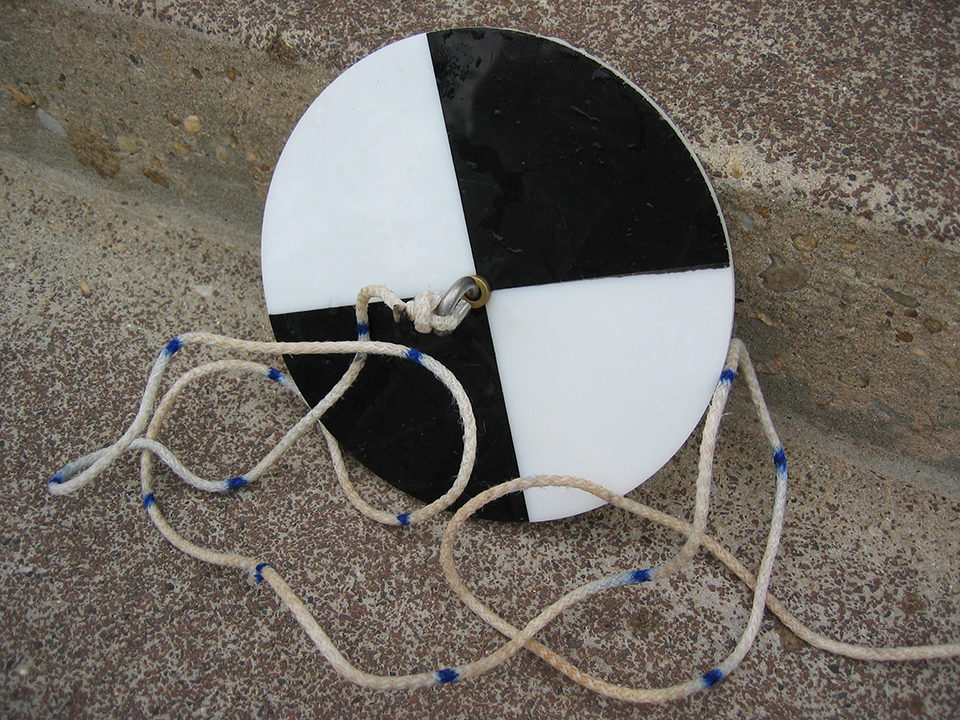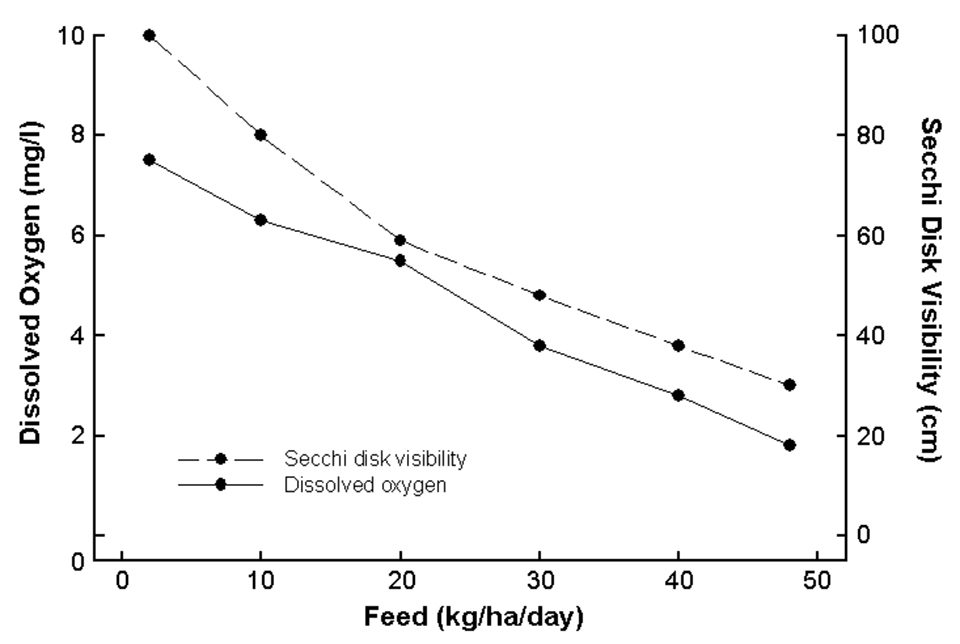Limnological instrument determines water clarity

Secchi disk visibility testing likely is the most frequent measurement of water quality made in pond aquaculture. It would be difficult to find a pond aquaculture worker who has not measured Secchi disk visibility or at least seen someone measure it. Still, this test is often executed incorrectly, and the limitations of its interpretation are often not fully understood.
Light penetration
The Secchi disk apparently was named after an Italian sea captain who in the early 1800s used the degree of disappearance of a white disk as an index of water clarity. The Secchi disk since has become a popular limnological instrument for determining the clarity of water.
The standard Secchi disk is a 20-cm-diameter disk with alternate black and white quadrants. It is attached to a calibrated line and fitted with a weight so it will sink rapidly. Secchi disk visibility usually is reported in centimeters, and in natural waters, the value may vary from a few centimeters to several meters.
The passage of light through a column of water is described by the equation:
Light at depth z = Incident light x e-kz
Where e = base of the natural logarithm (2.303),
k = the extinction coefficient, and z = depth in meters.
It has been shown that the extinction coefficient is related closely to Secchi disk visibility in meters:

Thus, Secchi disk visibility provides a reasonable way of comparing the ability of different bodies of water to transmit light. Limnologists are interested in light penetration because light is needed for photosynthesis. The greater the Secchi disk visibility, the deeper plant growth can occur in a water body.
Generally, there is enough light for plant growth down to about twice the Secchi disk visibility. Thus, twice the Secchi disk visibility is a rough estimate of the depth of the photic zone in lakes, ponds, and other water bodies.
Guidelines for use
Because Secchi disk visibility is used to compare clarity among water bodies, a standard procedure must be followed in its measurement or serious errors in interpretation can occur. Guidelines for correct Secchi disk visibility measurement follow.
- The disk should be slowly lowered until it just disappears from view and raised until it just reappears. The average of the two measurements should be used as the Secchi disk visibility.
- The measurement should be made on clear or partly cloudy days when the sun is not obscured by clouds.
- The reading should be taken with the sun behind the observer.
- The observer’s face should be within 25-50 cm of the water surface while making the reading.
- The observer should not wear sunglasses while making the measurement.
Application
Secchi disk visibility can be used in aquaculture to determine whether light conditions are suitable for the growth of underwater weeds on pond bottoms. It is excellent for this purpose because Secchi disk visibility is correlated strongly with turbidity. A more common use of the Secchi disk in aquaculture is to determine the adequacy of the plankton bloom for fish or shrimp culture and serve as an indicator of the need for fertilizer applications.
Water turbidity
Plankton often are the major source of turbidity in pond water, but particles of mineral soils and suspended nonliving organic matter also create turbidity. Thus, a small Secchi disk visibility means a water mass is turbid but does not necessarily indicate there is a heavy plankton bloom.
Plankton usually give water a green, yellow, blue-green, or brown color. Suspended mineral particles impart a color similar to that of surface soil in the area – usually brown, yellow, or red. Thus, plankton and nonliving particles sometimes give water similar colors. However, when viewed in a clear glass held in bright light, particles of nonliving matter are smaller than those of plankton and more regular in shape.
Most water is turbid because of a mixture of mineral particles, organic matter, and plankton. The relationship between Secchi disk visibility and measures of plankton abundance, such as chlorophyll a concentration, is not as strong as its relationship to turbidity.
Water from a particular source used to fill an aquaculture pond has a certain level of turbidity. In some ponds, the water may be very clear, while in others it may be noticeably turbid. The addition of nutrients in aquaculture usually stimulates plankton abundance and causes turbidity to increase with a corresponding decrease in Secchi disk visibility below the background level.
Secchi disk visibility guidelines, such as those developed for ponds at the Auburn University Fisheries Research Unit in Alabama, USA, (Table 1) are not applicable to all situations. Secchi disk visibility associated with plankton levels differs with background turbidity. The guidelines in Table 1 are for water where the background turbidity is 100-120 cm. If background turbidity is greater, the criteria may not apply. However, the Secchi disk visibility necessary to shade pond bottoms and prevent underwater weed infestations is similar almost everywhere.
Boyd, Interpretation of Secchi disk visibility, Table 1
| Secchi Disk Reading (cm) | Comments |
|---|
Secchi Disk Reading (cm) | Comments |
|---|---|
| Less than 20 cm | Pond too turbid. If pond is turbid with phytoplankton, there are likely to be problems with low dissolved oxygen concentrations in the early morning. When turbidity is from suspended soil particles, productivity will be low. |
| 20-30 cm | Turbidity becoming excessive. |
| 30-45 cm | If turbidity is from phytoplankton, pondis in good condition. |
| 45-60 cm | Phytoplankton becoming scarce. |
| More than 60 cm | Water is too clear. Inadequate productivity |
Where Secchi disk data is used to evaluate plankton abundance, the change in Secchi disk visibility over time is more telling than the magnitude of its values. When Secchi disk visibility increases as the result of declining turbidity, the change may be caused by declining plankton abundance or the settling of nonliving particles. If observation of the water suggests the declining turbidity is caused by a diminishing plankton bloom, fertilizer may be applied to encourage more phytoplankton. Following a successful fertilizer application, Secchi disk visibility would be expected to decline in response to greater plankton abundance.
Morning D.O. values
The relationship between Secchi disk visibility and early-morning dissolved oxygen concentration is critical, especially in ponds where aeration is not applied daily. The minimum acceptable disk visibility for a pond can be established by plotting daily dissolved oxygen concentrations measured soon after dawn against Secchi disk visibility. There usually is a good relationship among daily feeding rate, Secchi disk visibility, and dissolved oxygen concentration, as illustrated by the data for channel catfish ponds at the Auburn University Fisheries Research Unit in Fig. 1.

(Editor’s Note: This article was originally published in the February 2004 print edition of the Global Aquaculture Advocate.)
Now that you've finished reading the article ...
… we hope you’ll consider supporting our mission to document the evolution of the global aquaculture industry and share our vast network of contributors’ expansive knowledge every week.
By becoming a Global Seafood Alliance member, you’re ensuring that all of the pre-competitive work we do through member benefits, resources and events can continue. Individual membership costs just $50 a year. GSA individual and corporate members receive complimentary access to a series of GOAL virtual events beginning in April. Join now.
Not a GSA member? Join us.
Author
-

Claude E. Boyd, Ph.D.
Professor, Department of Fisheries and Allied Aquacultures
Auburn University
Auburn, Alabama 36849 USA
Tagged With
Related Posts

Responsibility
Light penetration in water
Light penetrating water is scattered and absorbed exponentially as it passes downward. The presence of dissolved organic matter and suspended solids further impedes light penetration, and different types of solids absorb different wavelengths.

Health & Welfare
The oft-overlooked water quality parameter: pH
Attention to pH, a numeric scale used to specify the acid or alkaline condition of an aqueous solution, is very important. Reducing biomass and feeding rates together with phytoplankton control and liming can often keep pH at desirable values.

Responsibility
Effluent effects from aquaculture ponds
In general, lower-intensity pond and cage farming tends to discharge higher overall pollution loads in farm effluents than closed aquaculture systems.

Responsibility
Phytoplankton dynamics in aquaculture ponds
Phytoplankton are essential in intensive aquaculture ponds but an excess can result in shallow thermal stratification.

